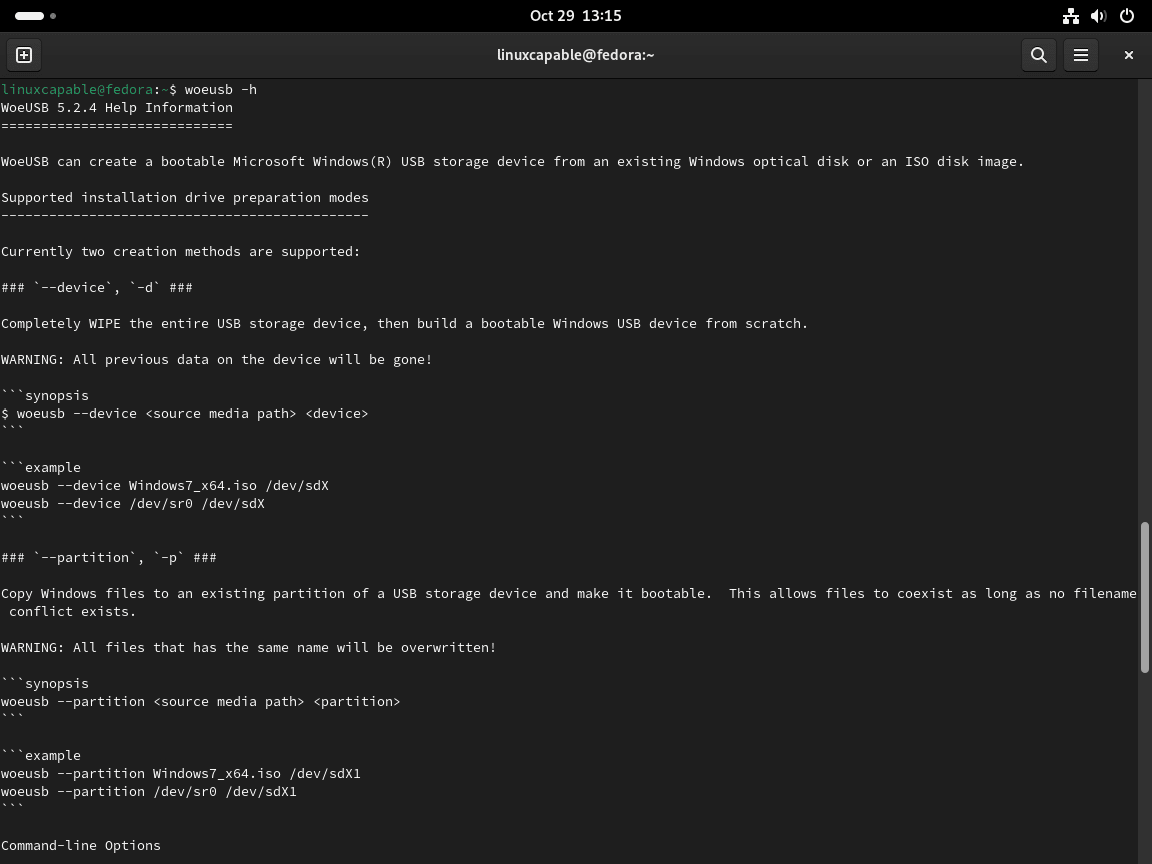WoeUSB is a powerful, open-source tool designed to create a bootable Windows USB drive from an ISO or a DVD on WoeUSB is a simple tool that allows you to create a bootable Windows USB drive from an ISO image or a DVD. It’s particularly useful for users who need to install or repair Windows on their machines but prefer to do so from a Linux environment. WoeUSB supports both UEFI and Legacy BIOS boot modes, making it a versatile tool for creating Windows installation media.
On Fedora 40 or 39, WoeUSB can be installed directly via the Fedora AppStream, which provides a stable and straightforward installation process. This guide will walk you through the steps to install WoeUSB using the command-line terminal, ensuring you have the tool set up and ready to create bootable Windows USB drives.
Check Availability of WoeUSB
Begin by confirming the availability of WoeUSB in Fedora’s package repositories. Execute the following command in the terminal:
sudo dnf search WoeUSBThis command searches the repositories to ensure that WoeUSB can be installed on your system.
Install the WoeUSB Package
Once confirmed, proceed to install the WoeUSB package. Use the command below, paying attention to the case sensitivity of the package name:
sudo dnf install WoeUSBIt’s crucial to note that the command distinguishes between uppercase and lowercase letters, requiring the input to be “WoeUSB” rather than “woeusb.”
Verify WoeUSB Installation
After installation, verifying that WoeUSB is correctly installed on your system is important. Check the installed version by executing:
woeusb -vThis command will display the version of WoeUSB installed on your system, confirming the successful installation.
WoeUSB CLI Commands
Once you install WoeUSB on your Fedora system facilitates the creation of bootable Windows USB drives from ISO images or DVDs. As a versatile tool, you can tailor WoeUSB commands to meet various requirements, ranging from straightforward bootable USB creation to more complex tasks such as troubleshooting and customization.
WoeUSB Help Command
First, you may want to bring up the WoeUSB help by executing the following command:
woeusb -h
Create a Bootable USB via WoeUSB
Basic Command
The illustration below shows the fundamental command to forge a bootable USB drive:
woeusb --device /path/to/windows.iso /dev/sdXHere, replace /path/to/windows.iso with the actual path to your Windows ISO file, and /dev/sdX with the device path of your USB drive.
woeusb --device /home/user/Downloads/windows10.iso /dev/sdbIn this instance, a bootable Windows 10 USB drive is concocted from the windows10.iso file housed in the Downloads folder.
Formatting a USB Drive with WoeUSB
Before venturing into the creation of a bootable USB, it’s prudent to format the USB drive as illustrated:
Example:
sudo mkfs.ntfs /dev/sdXHere, substitute /dev/sdX with the device path of your USB drive.
Example:
sudo mkfs.ntfs /dev/sdbDebugging with WoeUSB
Encountering hiccups while utilizing WoeUSB is not uncommon. Enabling verbose output can be instrumental in debugging:
woeusb --device /path/to/windows.iso /dev/sdX --verboseExample:
woeusb --device /home/user/Downloads/windows10.iso /dev/sdb --verboseWoeUSB Additional Parameters
Supplementary parameters equip WoeUSB to fine-tune the process to your liking. Some notable parameters include:
–target-filesystem
This parameter designates the filesystem of the target USB drive, supporting both NTFS and FAT32.
woeusb --device /path/to/windows.iso /dev/sdX --target-filesystem NTFSExample:
woeusb --device /home/user/Downloads/windows10.iso /dev/sdb --target-filesystem NTFS
–partitioning
This parameter is handy when you prefer to partition the target device, especially beneficial if you have other data on the USB drive you wish to retain.
woeusb --device /path/to/windows.iso /dev/sdX --partitioningExample:
woeusb --device /home/user/Downloads/windows10.iso /dev/sdb --partitioningConclusion
With WoeUSB installed on your Fedora system via Fedora AppStream, you can easily create bootable Windows USB drives with support for both UEFI and Legacy BIOS systems. This method provides a reliable and straightforward installation, ensuring that you have a powerful tool at your disposal for managing Windows installations from a Linux environment. Regular updates from Fedora’s repositories will keep your WoeUSB installation current, making the process of creating Windows installation media seamless and efficient on Fedora.

